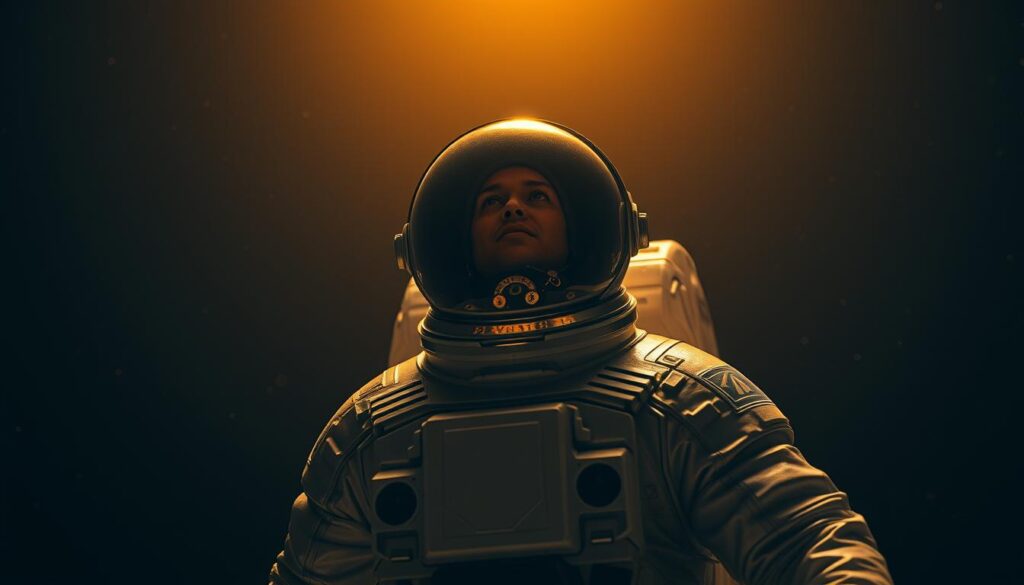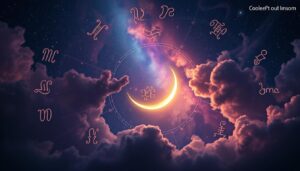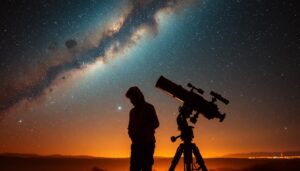The night sky reflects our deepest emotions. Looking at stars or watching rockets soar, we feel both thrill and trepidation. This piece delves into how fear and fascination drive our quest for cosmic knowledge. From ancient myths to today’s science, these feelings fuel our endless search for answers about the universe.
Key Takeaways
- The cosmos inspires awe and fear, creating a push-pull dynamic in human curiosity.
- Human history links cosmic events to both hope and existential concerns.
- Modern technology reveals new mysteries, deepening our obsession with space.
- Understanding fear and fascination helps explain why space exploration matters.
- Our emotions toward the cosmos shape how we approach scientific discovery.
The Cosmic Perspective: An Overview of Human Emotion
Human emotions and the cosmos are deeply connected. They dance with fear and fascination. From ancient times to today, the cosmos sparks our curiosity. It also makes us question our place in the universe.
What Draws Us to the Cosmos?
There are three main reasons for this connection:
- Survival instincts: Knowing space helps us face dangers like asteroids.
- Curiosity about origins: We wonder about the start of life and if we’re alone in the universe.
- Beauty in scale: The vastness of nebulae and galaxies fills us with awe.
“The cosmos is within us; we are a way for the universe to know itself.” — Carl Sagan
A Brief History of Cosmological Fascination
Here are some key moments in our relationship with the cosmos:
| Period | Key Figures/Events | Impact |
|---|---|---|
| Ancient Civilizations | Mythologies, Stonehenge | Explained natural phenomena through stories |
| Renaissance | Copernicus, Galileo | Shifted Earth’s perceived centrality in the cosmos |
| 20th Century | NASA, Apollo 11 | Turned space exploration from myth to reality |
These moments show how fear and fascination have always been with us.
The Dual Nature of Fear and Fascination
Humans are always pulled between fear and curiosity when looking at the cosmos. This emotional battle shapes our journey into space. Fear tells us to be careful, while curiosity pushes us to explore more.
Understanding the Psychology of Fear
Our ancestors learned to fear the unknown. Dark skies and distant galaxies make us wonder what’s out there. But this fear can also be good. It makes us more careful and curious.
The Role of Curiosity in Fascination
“Imagination will often carry us to worlds that never were,” said Carl Sagan. “But without it, we go nowhere.”
Curiosity is what drives us to discover. NASA’s Perseverance rover on Mars is a great example. It analyzes rocks and collects samples, expanding our knowledge. Curiosity also boosts creativity, helping us face challenges in space.
- Neuroscience shows curiosity is linked to dopamine, making space exploration exciting.
- Psychologists say fear keeps us safe, while curiosity pushes us to explore.
This balance between fear and curiosity is what drives space exploration. Without fear, we might ignore dangers. Without curiosity, we wouldn’t explore at all. This mix is what keeps us moving forward in space.
The Universe’s Enigmatic Mysteries
Space fascinates us with its mysteries and unknowns. It has invisible giants and colorful gas clouds. These cosmic wonders challenge our understanding and draw us in.
Black Holes: The Fear of the Unknown
Black holes are beyond our grasp, with gravity so strong it traps light. They inspire awe but also fear. Scientists use telescopes to study them, capturing images of their dark centers.
Their presence tests our curiosity and survival instincts. It’s a reminder of the vast unknown.
The Beauty of Nebulae and Galaxies
“Nebulae are nature’s canvases, painted with colors from exploding stars.” – NASA astronomers
Nebulae like the Orion Nebula shine with red and blue colors, made from star dust. Galaxies, like Andromeda, show the universe’s grand scale. These sights mix art and science, captivating us.
Telescopes, like Hubble, uncover new wonders. They show us how beauty and mystery blend in space.
Space Exploration: Beyond Earthly Boundaries
Space exploration turns the fear outer space into a gateway for discovery. NASA’s missions, like the Apollo moon landings and the Perseverance rover on Mars, transform uncertainty into curiosity. By sharing stunning images and scientific data, these ventures make the cosmos feel less remote.

NASA’s Role in Fostering Wonder
NASA bridges the gap between awe and anxiety. Their live broadcasts of rocket launches and astronaut interviews let everyone witness space’s beauty firsthand. Missions like the Hubble Space Telescope’s deep-sky images show galaxies and nebulae as vibrant, not ominous. Through educational programs like NASA’s STEM initiatives, they teach students how science turns fear outer space into inspiration.
- Over 200 Mars missions since 1965
- 100+ international collaborations on the International Space Station
- Live broadcasts viewed by 1 billion+ people annually
The Impact of Space Missions on Public Perception
Public perception shifted as missions revealed space’s tangible wonders. The Apollo 11 moonwalk in 1969 replaced fear outer space with national pride. Modern missions like SpaceX’s Crew Dragon flights show space travel as routine, not terrifying. Social media platforms amplify this shift, with viral clips of astronauts floating or describing Earth from orbit.
“Every launch is a step toward understanding what we once feared.” — NASA Administrator Bill Nelson
By sharing risks and triumphs openly, NASA humanizes exploration. This transparency turns fear outer space into curiosity, proving humanity’s resilience in the unknown.
The Influence of Science Fiction on Our Psyche
Science fiction reflects our wonder and fear of the cosmos. Stories like War of the Worlds or Alien make space thrilling and unsettling. But they also spark our curiosity, encouraging us to explore.
Fear-Inducing Themes in Sci-Fi Literature
Classic tales, like H.G. Wells’ The War of the Worlds, play on our fear of the unknown. Movies like Event Horizon or Annihilation create eerie settings that reflect our deep-seated fears. They ask us: What lies beyond our reach?
How Sci-Fi Inspires Scientific Inquiry
Sci-fi is more than just stories—it drives discovery. NASA’s Mars rovers were inspired by The Martian. The Star Trek tricorder even led to real medical scanners. Here’s how imagination meets science:
| Sci-Fi Concept | Real-World Impact |
|---|---|
| Wormholes (Interstellar) | Research into spacetime physics |
| AI in 2001: A Space Odyssey | Advances in AI ethics studies |
Sci-fi mixes fear and wonder, shaping our view of the cosmos. As Arthur C. Clarke said, “The only way to find the limits of the possible is by exploring the impossible.” This mix of caution and curiosity shows how imagination fuels discovery.
Cultural Interpretations of the Cosmos
Humans have always been drawn to the universe. This fascination shows up in myths and movies. From old tales to new shows, our fear and wonder shape how we see the stars. This section explores how ancient stories and today’s media reflect our cosmic struggles.
Mythology and Cosmology Through the Ages
Early societies used myths to understand the sky. The Greeks saw gods in the stars, while Mesoamericans feared eclipses. These tales mixed awe with fear, showing our cosmic obsession is ancient.
- Roman: Jupiter’s thunderbolts as divine power
- Chinese: The moon goddess Chang’e’s lonely journey
- Incan: Inti, the sun god’s life-giving rays
| Aspect | Ancient Views | Modern Media |
|---|---|---|
| Fear Source | Angry deities | Alien invasions |
| Symbolism | Rainbow bridges (Bifrost in Norse myth) | Spaceship disasters in *Alien* films |
Modern Media’s Take on Space Fear
Blockbusters like *Interstellar* mix wonder with fear. An astronaut says:
“The cosmos’ beauty is terrifying because it’s endless.”
Social media trends like #SpaceFascination show how TikTok creators mix DIY astronomy with horror-themed space content.
Documentaries like *Cosmos* turn fear into curiosity. They show our obsession with the universe never fades.
Understanding Cosmic Events and Their Implications
Cosmic mysteries fascinate us because they challenge our understanding of the universe. Events like explosive stellar deaths and ancient space rocks show both beauty and danger.
Supernovae: Awe and Anxieties
Supernovae, the explosive deaths of massive stars, spark both curiosity and fear. These events briefly outshine entire galaxies, scattering elements like iron and gold into space. Yet, their power poses risks: a nearby supernova could strip Earth’s ozone layer.
Scientists track them to study star life cycles and assess threats to our planet.
The Potential of Asteroids and Comets
Asteroids and comets hold clues to the origins of our solar system. NASA’s OSIRIS-REx mission studied Bennu, an asteroid carrying primordial materials. Yet, their paths also raise concerns.
In 2029, Apophis will pass closer than the Moon—a reminder of collision risks. These cosmic wanderers symbolize duality: keys to cosmic history and potential hazards.
“Asteroids are fossils of the cosmos, but their paths demand vigilance.”
Understanding these events blends wonder with responsibility. By studying them, we unravel cosmic mysteries fascination while safeguarding our future. From telescopes to planetary defense, humanity’s dual response—awe and action—defines our cosmic journey.
The Psychological Effects of Cosmic Awareness
Looking at the stars can make us feel both thrilled and scared. This mix of feelings helps us understand the vastness of the universe and our role in it. Embracing these emotions can lead to a more balanced mind.

Anxiety vs. Awe: Finding Balance
Feeling tiny in the universe is common. Here are ways to balance fear and wonder:
- Learn about the cosmos to calm your mind
- Join astronomy groups for shared views
- Practice mindfulness to stay in the moment
Coping with Existential Dread
Feeling insignificant can cause deep anxiety. Try these methods to cope:
| Strategy | Benefit |
|---|---|
| Study cosmic history | Builds understanding of humanity’s resilience |
| Volunteer for science outreach | Connects to collective curiosity |
| Create art inspired by space | Transforms anxiety into creativity |
“The universe is under no obligation to make sense to you.” – Neil deGrasse Tyson
Accepting the unknown can lessen fear. Let curiosity lead you, rather than being overwhelmed by questions.
Technology and the Future of Space Exploration
Our journey into space depends on new ideas. Tech like reusable rockets and AI robots is changing space travel. Let’s see how these innovations make science fiction come true.
- Reusable rockets (like SpaceX’s Starship) make space travel cheaper.
- Robotic explorers, such as NASA’s Perseverance rover, explore tough places.
- 3D-printed habitats could build homes on Mars using Martian soil.
“AI isn’t just code—it’s our co-pilot to the stars.” – Dr. Sara Seager, MIT Astronautics Expert
AI is becoming more important every day. It can look through telescope data faster than we can, finding new planets or tracking asteroids. Companies like IBM work with ESA to predict space weather, protecting satellites. These tools help solve problems and ask new questions.
Future missions might have AI running bases on the Moon. Quantum computing could make interstellar travel faster. As technology grows, so do our dreams of exploring space.
The Search for Extraterrestrial Life
Humans have always looked up at the stars, wondering if we’re alone. The search for alien life is filled with hope and doubt. NASA’s missions and telescopes, like the James Webb Space Telescope, search for signs of life on other planets. Every find, like water on Mars or methane on Titan, makes us curious and raises more questions.
Fear of the Unknown: What If?
What if we find life? Some fear alien invasions or big changes in society. Scientists talk about how to contact aliens, like SETI (Search for Extraterrestrial Intelligence). Even finding microbes on Mars could change how we see biology. We wonder: Could life beyond Earth be a threat, or could it help us?
Fascination with the Possibilities
Finding life beyond Earth could bring us together. Imagine sharing technology or learning about other civilizations’ pasts. Missions like Kepler have found thousands of planets that might support life. The potential for connection drives projects like Breakthrough Listen, which scans stars for signals.
| Concerns | Hopes |
|---|---|
| Alien pathogens | Shared scientific breakthroughs |
| Resource competition | Proof life is common in the universe |
| Cultural shock | New energy sources from alien tech |
Astrobiology: The Intersection of Science and Imagination
Scientists study life’s extremes to unlock secrets of cosmic existence. Astrobiology merges lab research with cosmic wonder. It explores how life adapts beyond Earth-like conditions. This field bridges reality and imagination, guiding humanity’s search for life beyond our planet.
Examining Extremophiles as Life Examples
Deep-sea vents and acidic lakes host extremophiles—organisms thriving in harsh environments. These microbes, like Thermus aquaticus, show life can exist where we’d least expect. Their survival hints at possibilities on Mars or Europa’s icy oceans.
- Heat-loving archaea in volcanic springs
- Salt-resistant bacteria in Utah’s Bonneville Salt Flats
- Ice-dwelling fungi in Antarctica
The Fascination with Habitable Exoplanets
“Every star might host worlds where life could begin.” — NASA Exoplanet Exploration
Over 5,000 confirmed exoplanets reveal diverse conditions. Planets like Trappist-1e and K2-18b intrigue researchers. Telescopes like James Webb scan atmospheres for biosignatures—gases suggesting life. This quest mixes cutting-edge tech with ancient human curiosity about the stars.
Conclusion: Embracing the Cosmos with Open Eyes
Humanity’s view of the cosmos has always been a mix of fear and wonder. This journey through cosmic mysteries and real exploration shows how curiosity helps us understand. Every new find, from black holes to distant planets, tells us the universe’s stories are still being written.
Finding Comfort in the Unknown
NASA missions like Perseverance on Mars show us that science keeps moving forward. Mysteries like dark matter or alien life spark new ideas. Seeing fear as a chance to learn, not to hide, is key.
The Continuing Journey of Cosmic Discovery
Every space telescope scan and citizen science project invites us to explore more. Missions like TESS and apps like NASA’s “Eyes on the Solar System” let everyone join in. Whether stargazing at home or following lunar missions, our curiosity keeps us looking up. The cosmos is not just out there—it’s a part of us.



